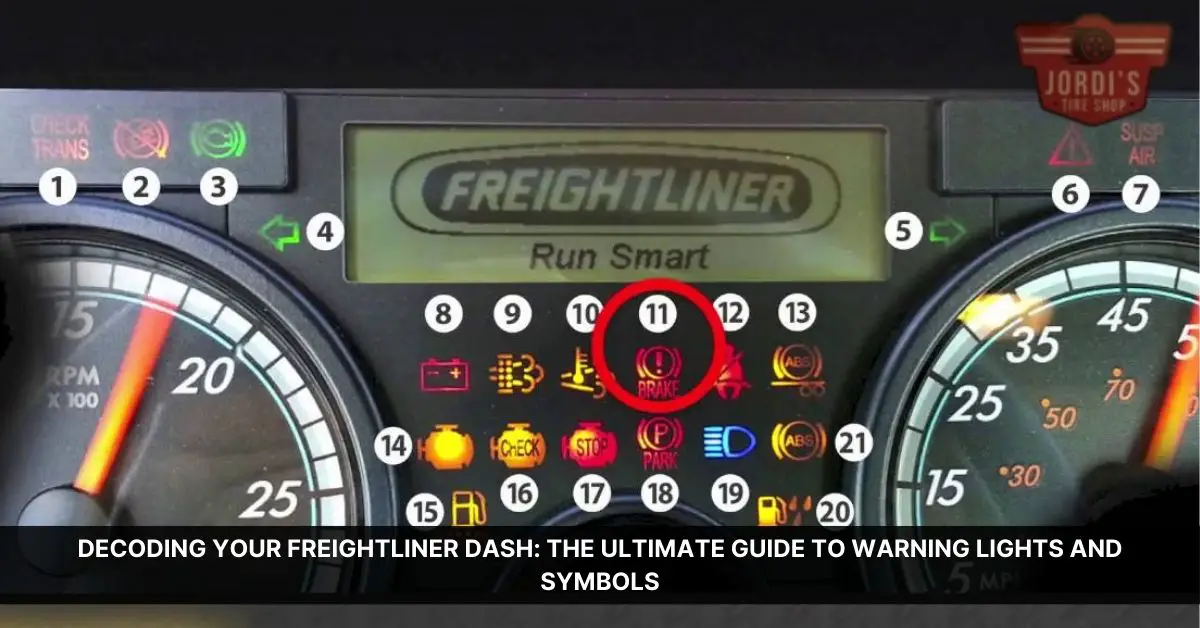You’re cruising down the highway in your trusty Freightliner, when suddenly, a warning light on your dash flickers to life. It’s a symbol you’ve never seen before. What could it mean?
Understanding your Freightliner’s dash warning lights and symbols is crucial for your safety and the longevity of your vehicle. These tiny, illuminated signs are your truck’s way of communicating potential issues that might need your attention.
In this text, we’ll decode these cryptic symbols, turning confusion into clarity. We’ll help you understand what your Freightliner is trying to tell you, so you can keep your wheels turning and your journey smooth.
Understanding Freightliner Dash Warning Lights and Symbols
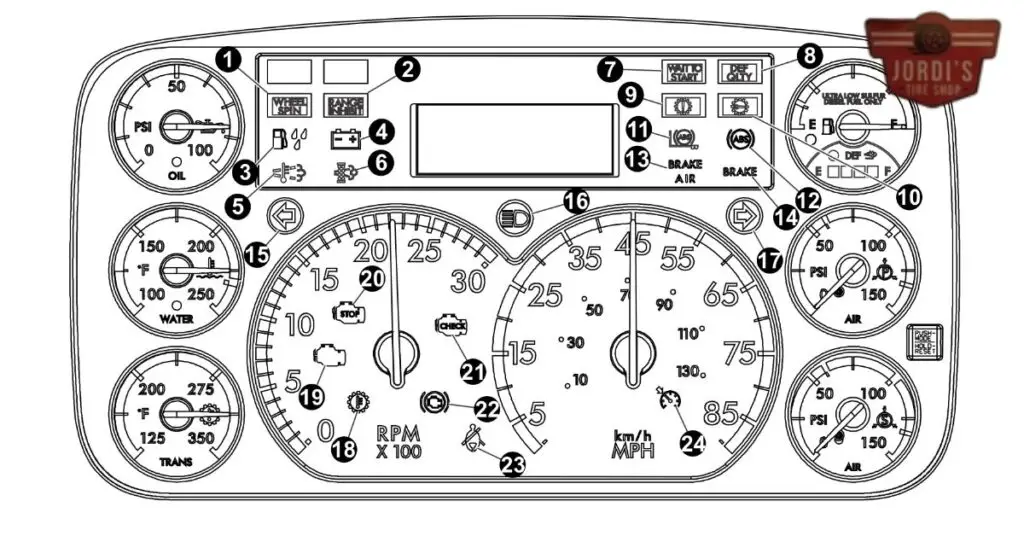
Grasping the distinct indicators on a Freightliner’s dashboard is crucial. Comprehending them not only ensures a safe journey but also guarantees vehicle longevity. Let’s reveal the meaning of dashboard symbols together.
The Importance of Freightliner Dashboard Symbols
Dashboard symbols in your Freightliner serve as imperative communication tools. They effectively reveal the health and status of your truck. These symbols alert you to a potential issue with your vehicle. Getting too familiar with them is never a bad thing.
For instance, a light that resembles an exclamation mark inside a horseshoe often signals an issue with the tires. It’s typically a tire pressure issue. Another common light is the check engine light. It’s not exact but can indicate anything from a loose gas cap to a serious engine problem. By interpreting these symbols correctly, you’re one step closer to troubleshooting the truck’s issue quickly and safely.
Your Freightliner’s well-being is heavily reliant on these symbols. They’re not there simply to make your dash look sophisticated. They’re crucial communication tools reminding you that timely maintenance and repairs are vital. Ignoring them can often lead to fatal breakdowns or costly repairs. Hence, understanding these symbols yields safe driving, prevents roadside breakdowns, and promotes the vehicle’s longevity.
Freightliner Dash Warning Lights: Types and Meanings
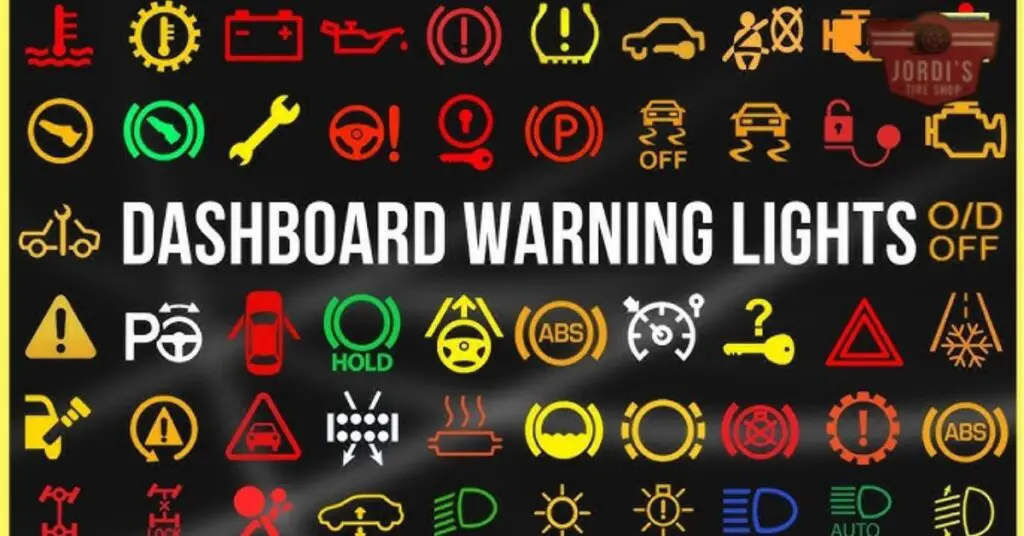
Equipped with knowledge of different lights and their meanings, maintain a safer journey and better vehicle upkeep. Here, let’s investigate deeper into the intricacies of Freightliner’s dashboard warning lights.
Warning Lights for Engine Issues
Address troubling engine issues promptly, knowing their representative warning lights. The engine warning light, symbolized by a stylized engine graphic, typically illuminates yellow. It signifies potential issues like emission system irregularities, inadequate fuel pressure, or even engine overheating. Meanwhile, an oil can symbol indicates oil pressure issues. It lights up when there’s insufficient oil pressure, necessitating immediate attention. Remember, engine management becomes more accessible when you correctly identify these light indicators.
Indicator Lights for Brakes, ABS, and Traction Control
Prioritize vehicle safety by comprehending lights associated with vehicle control systems. The brake system warning light displays as a circle with an exclamation mark. It lights up when there’s a malfunction in the brake system. Two glaring examples include worn-out brake pads or brake fluid leak. In contrast, the ABS (Anti-Lock Braking System) warning light bears the ‘ABS’ inscription. It’s a sign of potential ABS malfunctions, limiting braking responsiveness on slippery surfaces. Finally, a car skidding symbol signifies issues with the Traction Control System (TCS). It helps control vehicle stability and grip during acceleration. Grasp these light indicators to maintain vehicle safety standards.
Freightliner’s Unique Warning Signs
Harmonize with your Freightliner truck, recognizing its unique warning signs. The DEF (Diesel Exhaust Fluid) light, for instance, embodies an amber droplet icon. It comes on when DEF levels are critically low, affecting emissions standards. Frequent sightings of this icon may require replenishing DEF fluid levels. Also, Freightliner features a DPF (Diesel Particulate Filter) warning light, indicator of necessary regeneration. The check DPF light indicates that the filter needs to be regenerated, typically via a prolonged highway drive. Familiarization with these unique signs fosters long-term vehicle care and effective emissions control.
Common Misunderstandings About Warning Lights Symbols
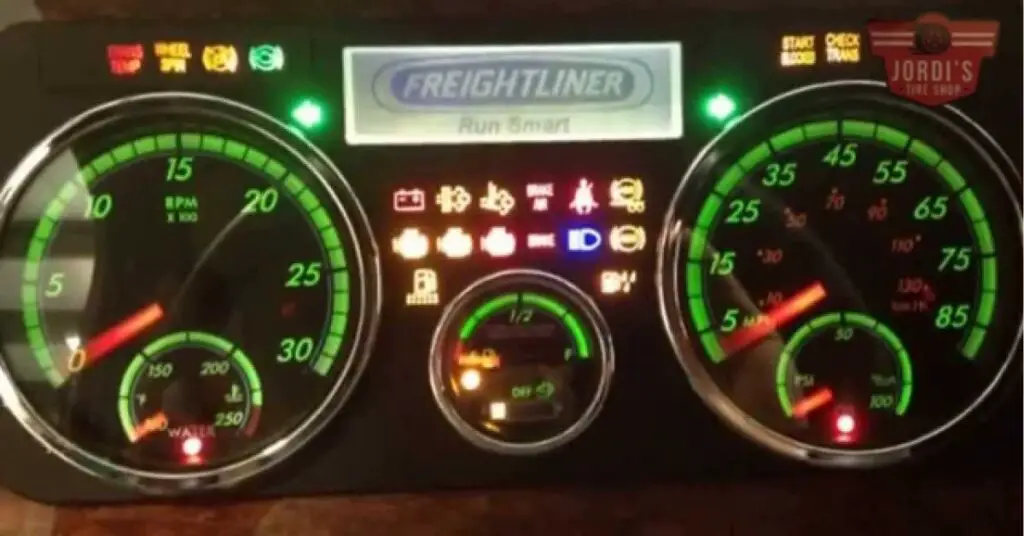
Navigation through the labyrinth of Freightliner dashboard warnings is often strewn with misconceptions. Let’s clear them up.
Decoding the Colors of Warning Lights
Understanding the colors of warning lights, contrary to popular belief, isn’t as daunting. Dashboard warning lights generally follow a standard color scheme: red, yellow or amber, and green or blue.
Red lights are critical alerts, indicating a severe issue, such as low oil pressure, that requires immediate attention. It’s a mistake to ignore these; early intervention can prevent important damage or breakdowns.
Yellow or amber lights symbolize a warning. For instance, the yellow engine warning light signifies potential problems like emission system irregularities or engine overheating. They aren’t imminent threats but warrant attention at the earliest convenience to avoid escalation into a red alert.
Green or blue lights, often misunderstood as warnings, don’t raise any concerns. These correspond to the activation of exact systems, like high beam headlights or cruise control. Time to relax, not panic, when they light up your dash!
Ensure you consider the color code of these dash warning symbols along with their individual meanings to better interpret your truck’s communication. A proper grasp of these color cues optimizes your response time, ensuring both your safety and your vehicle’s longevity.
Troubleshooting Freightliner Warning Lights
Understanding your Freightliner’s dashboard warning lights and symbols is critical to your safety and the longevity of your truck. A few simple troubleshooting steps could have a important impact on these factors.
Step-by-Step Guide to Addressing Common Warning Lights
First, identify the warning light. The symbol on the light can provide a lot of information about the problem. Ensure you clearly understand the meaning of each symbol on the dashboard, and have resources on hand if you need help with identifying one.
Next, analyze the severity indicated by the color of the warning light. If it’s red, this is an urgent warning, requiring immediate attention. A yellow or amber light serves as a caution, indicating a potential problem that should be addressed soon.
Then, look for any abnormalities with your truck’s performance. This could include strange noises or changes in handling, acceleration or gas mileage. Any of these symptoms, coupled with a warning light, means an issue that needs your immediate attention.
For lights indicating an engine problem, check the truck’s fluids such as oil, coolant, and brake fluid. In many cases, low fluid levels can trigger these warning lights. If the oil pressure light illuminates, don’t ignore it. Park the vehicle safely and check the oil level as soon as possible.
If the tire pressure light turns on during your journey, it’s time to check the tire pressure. A light resembling an exclamation mark inside a horseshoe usually indicates this issue.
For Freightliner exact warnings like the DEF (Diesel Exhaust Fluid) light and the DPF (Diesel Particulate Filter) warning light, refer to your Freightliner manual or consult a mechanic to understand the best course of action.
Remember, ignoring these notifications can lead to further mechanical damage and even more costly repairs. Being proactive will not only save you money but also ensure your truck’s longevity and your safety.
How to Prevent Warning Lights from Coming On
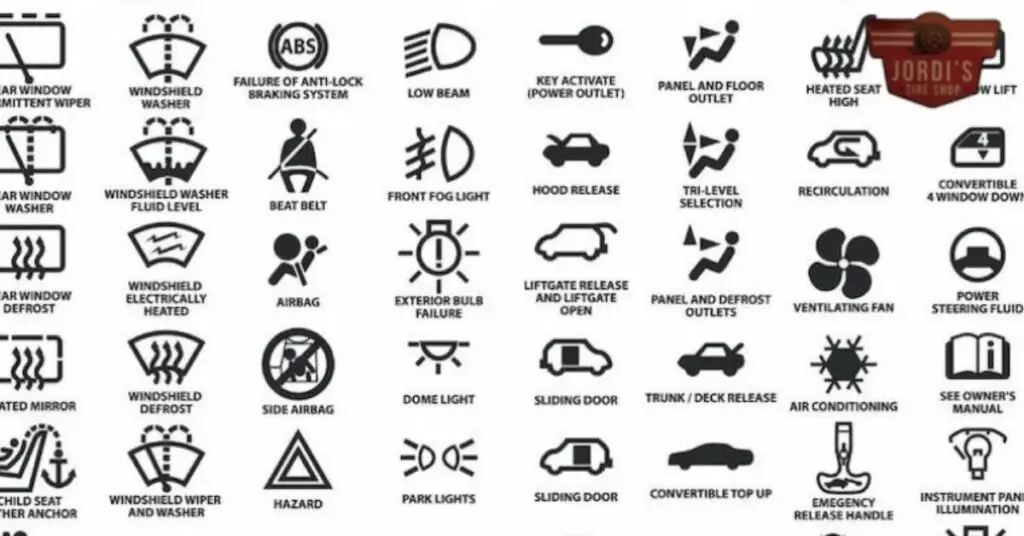
Preventing the illumination of warning lights on your Freightliner’s dashboard isn’t a Herculean task. It’s simply a matter of diligent maintenance and effective preemptive measures, which can ward off potential vehicle distress. Let’s investigate into the intricacies of regular maintenance tips and the utilization of onboard diagnostic (OBD) systems.
Regular Maintenance Tips
Regular maintenance stands tall as an effective way to stave off warning lights on your truck’s dash. Penciling in timely check-ups, adhering to maintenance schedules and swift problem resolution can help keep your Freightliner in peak running condition. Let’s break down these maintenance tips:
- Keeping tabs on fluid levels encourages a healthy engine. Check the engine oil, brake fluid, transmission fluid, and coolant levels regularly, topping up as necessary. For instance, low engine oil level often results in the illumination of the oil pressure warning light.
- Regular tire checks go a long way. Ensure tires are inflated to the correct pressure, undamaged and have ample tread depth. Since an exclamation mark inside a horseshoe light could symbolize a tire pressure issue, these checks can keep it at bay.
- Brake maintenance keeps brake-related warning lights off your dashboard. Regular tests for their responsiveness, checks for wear in brake pads and timely change of brake fluid comprise comprehensive brake upkeep.
- Battery checks can preclude battery-related warnings. Visually inspect its terminals for corrosion and examine its voltage to ensure it’s holding charge.
- Staying attentive to the DEF (Diesel Exhaust Fluid) light and the DPF (Diesel Particulate Filter) warning light requires regular maintenance. Careful monitoring of the Diesel Exhaust Fluid levels and timely Diesel Particulate Filter changes can prevent the appearance of Freightliner-exact warning lights.
Adhering to these regular maintenance tips can position your Freightliner for smooth and safe journeys, free from the interruption of warning lights. Remember, the more you invest time and care into your vehicle, the less it’ll be likely to flag up concerns in the form of dashboard lights.
You may also find it fruitful to leverage your Freightliner’s onboard diagnostic system. It can assist in steering clear of unnecessary warning lights by providing early indications of potential issues. Let’s explore this further.
Conclusion
Understanding your Freightliner’s dash warning lights and symbols is key to safe driving and vehicle longevity. These indicators aren’t just lights flashing on your dashboard; they’re your truck’s way of communicating its health and status. Recognizing what each symbol means, from the common check engine light to Freightliner-exact DEF and DPF warnings, empowers you to take timely action and prevent costly repairs.
The color coding of these lights is also crucial. Red alerts demand immediate attention, while yellow or amber ones are a call for prompt intervention. Green or blue lights simply indicate system activation, not a problem.
Remember, troubleshooting these warning lights doesn’t have to be a challenging job. With the right knowledge and a proactive approach, you can ensure your truck’s optimal performance. Regular maintenance and use of the OBD system can help you avoid unnecessary warnings. After all, your truck’s well-being is in your hands, and a well-maintained vehicle promises a smoother, safer journey.
What do the warning lights on a Freightliner’s dashboard signify?
The warning lights and symbols on a Freightliner’s dashboard function as important communication tools, indicating the health and status of the vehicle. They alert drivers to potential issues, with specific symbols relating to tire pressure, engine problems, oil pressure, brakes, ABS and traction control, and more.
Why is it essential to understand these dashboard symbols?
Understanding these dashboard symbols is paramount for ensuring the safety of the driver, timely maintenance, and vehicle longevity. Ignoring these indicators can lead to serious problems, costly repairs, and even breakdowns.
What does the color coding on dashboard warning lights mean?
Red lights indicate critical alerts needing immediate attention. Yellow or amber lights serve as warnings needing prompt attention, while green or blue lights signal the activation of specific systems, not warnings.
How should one troubleshoot Freightliner warning lights?
Troubleshooting should involve identifying the warning light and understanding its meaning, determining its severity through its color, and observing any truck performance abnormalities. Depending on the light, check fluid levels or tire pressure, or consult the vehicle manual or a mechanic.
How can one prevent dashboard warning lights from coming on?
Preventing warning lights requires diligent maintenance and proactive measures such as monitoring fluid levels, conducting tire checks, maintaining brakes, inspecting batteries, and using the onboard diagnostic (OBD) system for early issue detection. Regularly maintaining the DEF and DPF systems can also help prevent specific Freightliner warnings.
Related Posts:
- Troubleshooting 2018 Honda Accord: Deciphering the Mystery of All-On Dashboard Warning Lights
- Decoding Your Dodge Durango: A Comprehensive Guide to Dashboard Warning Lights and Symbols
- Understanding Your Chevy Malibu Dashboard Warning Lights: A Comprehensive Guide
- Unlocking the Mystery: Understanding Your Chrysler’s Dashboard Warning Lights & Symbols
- Decoding Your Freightliner Dash: The Ultimate Guide to Warning Lights and Symbols
- Decoding Bobcat Warning Light Symbols: Your Ultimate Guide for Safe and Efficient Operation
- Mastering Kubota’s Dashboard Warning Lights: A Guide to Efficient Machinery Maintenance
- Decoding Your Case Tractor Warning Lights: What They Mean and How to Respond
- Decoding John Deere Tractor Warning Lights: A Comprehensive Guide for Owners
- Unlock the Mystery: Understanding Your Kenworth Dash Warning Lights
- Decoding Case Skid Steer Warning Lights: A Guide to Optimizing Operations

